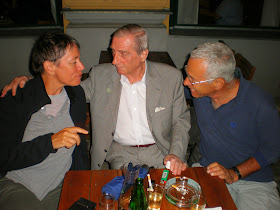
Well, No. 1 may have gone from last night's Proms programme - the Prokofiev First Piano Concerto, Martha Argerich's second promised offering of the evening, was a casualty of her recent illness, we're told - but what the great Argentinian did give us, Ravel's adorable G major Concerto, showed that she is surely first among pianists for wit, fantasy and tone-colour.
More surprising, for me, was the light and airy shape into which Dutoit had knocked the Royal Philharmonic Orchestra for the concerto, and what he did after the interval with the irresistible Prokofiev replacement, the Love for Three Oranges Suite, and the Musorgsky/Ravel Pictures from an Exhibition. Despite fine recordings with Gatti, the RPO has dropped off the performance radar for me in the last five years. I'll admit a falling-out with new marketing brooms sweeping in and demanding that notes had to be written to attract first-time listeners to concerts; so the big and money-losing Mahler cycle was the last thing I did with them. Anyway, great days are now ahead with Dutoit, that's obvious: and I say that as one who's always had my doubts about him. Whatever his faults, as a colourist he is surely the Ravel of the conducting world.
Even the 'new' work at the start, Claude Vivier's Orion, was a huge improvement on other beginners I've heard this season, namely Casken's Orion over Farne and Rebecca Saunders's traces. I say 'new' because although this was the UK premiere it was written in 1979, one of only two orchestral scores achieved by the French-Canadian composer before his death at the age of 34. Hurrah, a melodic shape seconds in, superbly articulated by the RPO's principal trumpeter (two are advertised in the programme, so I'd better not guess which; though of course it immediately made us anticipate the start of Pictures). And, sectional though the piece was, the drone bass + overtones on the strings towards the end were mesmerising; wish it had developed a little more.
Martha stunned us with Ravel's first flights up and down the keyboard, made us laugh with her comic timing, brought tears to the eyes with the hyper-poetic second subject, made the trill in the cadenza sound like some weird cimbalom and always tuned in to the chimerical orchestral playing. The start of the slow movement, though sensitive, projected into the hall as if we were in a salon yards away from the pianist (I was two-thirds of the way back in the arena), and Argerich's filigree floating over the cor anglais's reprise reminded me how Yuja Wang had missed the point at a similar moment in the Prokofiev Three with Abbado (also underlining that Ravel had probably heard and known that work, just as Prokofiev would often return the compliment). So here we had refinement without a sense of playing for oneself (the problem with Lang Lang in the slow movement of Chopin 2), just as in the finale there was helter-skelter danger in fast passages without scrambling (Stephen Hough, please note). The glorious encore, a Scarlatti sonata that sounded like Busoni, was if anything even more elusive and will-o-the-wispish. At its end, Martha led the RPO leader off: no more, alas.
Oh look, here she is playing the same piece in Turin last year. As usual with her, it's by no means the same interpretation. Again, scintillating pianism doesn't get any better than this:
This, by the way (2/10), has turned me back to pianistic Scarlatti sonatas. I hadn't taken my Pletnev recording off the shelf for years, and it's captivating, though in quite a different way: earth to Martha's air.
What was new for me about the Three Oranges Suite? Above all the full-throated brass playing, and a low horn solo in the bass line just before the end of 'The Flight' which I've never heard before. Dutoit in his advancing years is becoming as relaxed as my hero Neeme Jarvi - much shoulder conducting, lovely bounce for the March. And I tell you, for Radio 3's Building a Library I must have heard some forty or so recordings not just of the Ravel-orchestrated Pictures but all the others, and if this one were to sound as good on CD as it did from where I was standing, it would beat Jansons to the top of the list. My notes were reprinted in the programme and can still be read here.
Dutoit, after years of experience, fully grasps the interconnectedness of the drama, the distorted self-portraits even in the individual numbers between the Promenades, the terror of 'Catacombs'- oh, my goodness, five of the six surviving Hartmann paintings/sketches which inspired Musorgsky are on Wikimedia, so let's have the ones pertinent here -

and the Satanic timpani and bass drum dialogue at the start of the Baba Yaga flight (Hartmann only sketched the witch's 'Hut on Fowl's Legs' as a clock design).

If the Great Gate (strictly speaking 'The Bogatyr Gate at Kiev' - Hartmann's design features cupolas in the shape of a bridal headdress and a knight's helmet)

didn't broaden majestically at the end, that's true to the matter of fact spirit of Musorgsky (Jansons is even faster right at the end, and I like that). Mustn't forget the very prominent and artistic horn solo in the second 'Promenade' or the tuba with a nice touch of vibrato in 'Bydlo'. 'Tell me, wasn't that a really special performance?' asked the nice man behind us with two attentive children in tow. And I could boast, with my Building a Library anorakish-for-pay 'heard every one' behind me, that it was. I should just add that the audience, one or two coughers apart, couldn't have been more different from the Lang Lang crowd - more discerning piano lovers, perhaps, who'd booked their seats early - and their concentration played a palpable part throughout the evening.














































.jpg)

